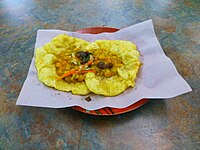
Photo from wikipedia
ABSTRACT Objective: Habitual spicy food consumption leads to altered perception of capsaicin. Little is known about the neural morphological correlates of habitual spicy food intake and related trigeminal perceptions. In… Click to show full abstract
ABSTRACT Objective: Habitual spicy food consumption leads to altered perception of capsaicin. Little is known about the neural morphological correlates of habitual spicy food intake and related trigeminal perceptions. In this study, we used voxel-based morphometry to identify brain regions where regional gray matter volume (GMV) correlates to spicy food consumption. Methods: Fifty-two participants were surveyed for their spicy food dietary habit by a composite score of spicy diet duration, frequency of spicy food consumption, and preferred degree of spiciness. Forty-two participants were further assessed for oral sensitivity and intensity ratings of capsaicin-induced irritation, and intranasal sensitivity and intensity of trigeminal odors. Results: We found that the composite spicy score was positively correlated to GMV of the primary somatosensory area (SI), and the primary (M1), supplementary motor areas (SMA) and the putamen. It was negatively correlated to GMV of the anterior insula, orbitofrontal cortex, frontal gyrus and angular gyrus. The GMV of the SI area was negatively correlated to capsaicin sensitivity; the GMV of the right middle frontal gyrus was positively correlated to the irritative intensity for capsaicin at high concentration (70 μM). However, we observed no correlation between the intranasal trigeminal sensitivity and spicy food consumption or the regional GMV. Discussion: Collectively our findings suggest a central neuroanatomical reflection of altered capsaicin perception in relation to habitual spicy food consumption. Future longitudinal studies should elucidate the possible causal relationship of dietary habit and brain structural plasticity.
Journal Title: Nutritional Neuroscience
Year Published: 2022
Link to full text (if available)
Share on Social Media: Sign Up to like & get
recommendations!